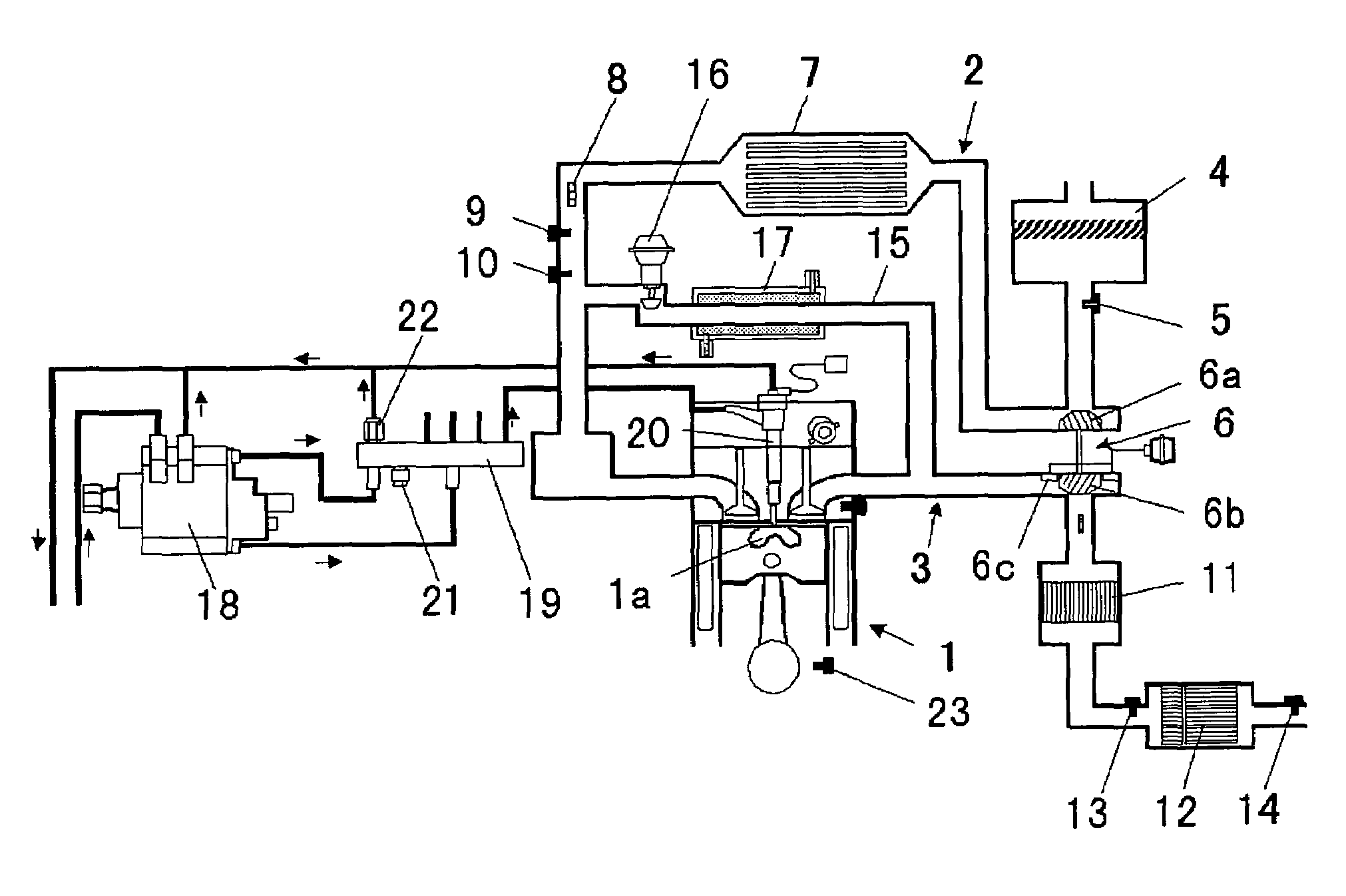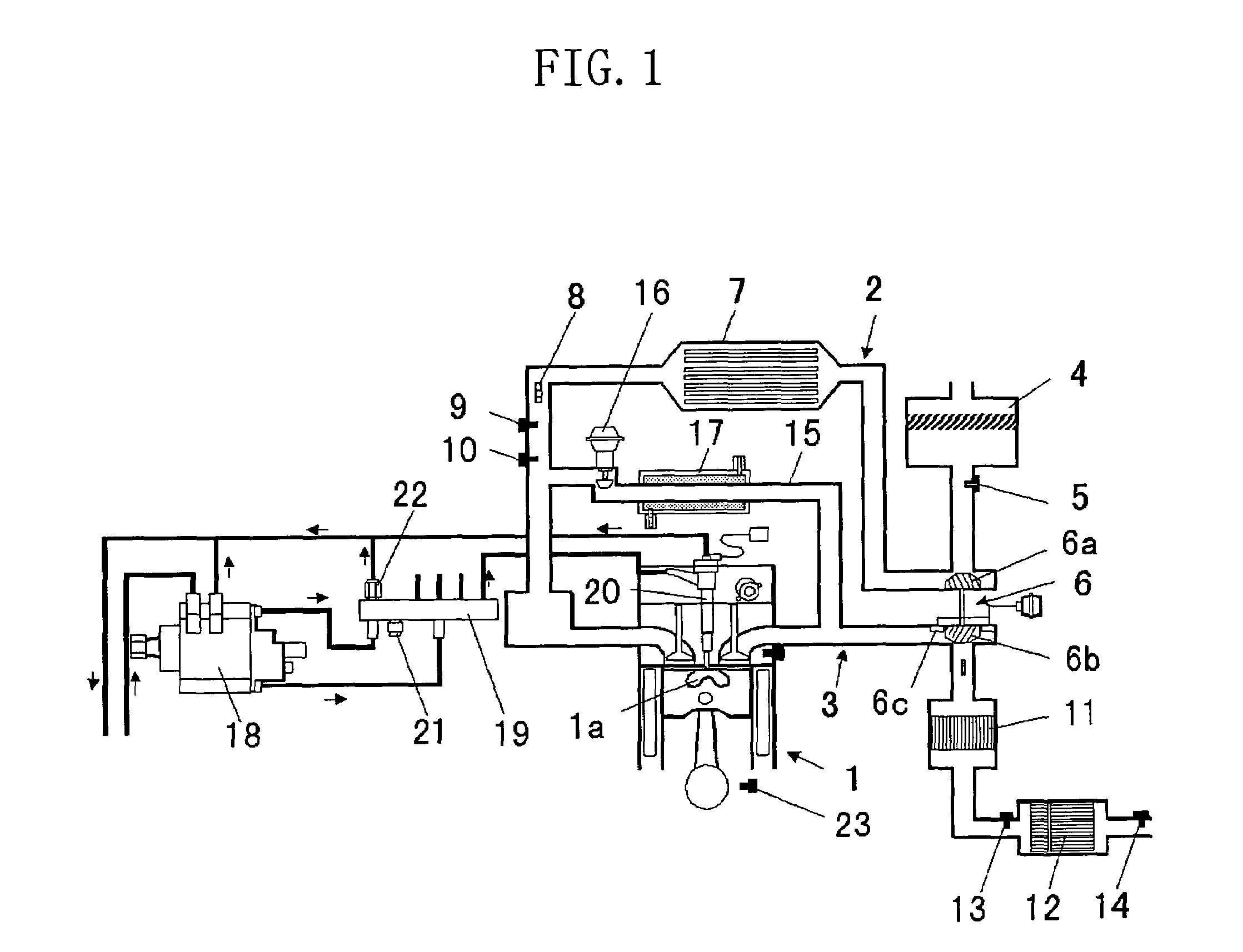Engine exhaust particulate after-treatment system
a technology of aftertreatment system and engine exhaust, which is applied in the direction of machines/engines, mechanical equipment, electrical control, etc., can solve the problems of deteriorating durability, not approaching the problem of dissolution loss of particulate filters, and increasing the temperature of particulate filters. to achieve the effect of suppressing the temperature ris
- Summary
- Abstract
- Description
- Claims
- Application Information
AI Technical Summary
Benefits of technology
Problems solved by technology
Method used
Image
Examples
embodiment 1
[0082]FIG. 2 is a control block diagram in Embodiment 1, and shows a case of restricting, when the engine operating condition changes to a deceleration condition during the removal by burning of exhaust particulates, the drop of the flow rate of exhaust gases flowing into the particulate filter 12. The controls in this case include: (a) compensating for the amount of recirculation of exhaust gases (EGR amount) subtractively; (b) compensating for the opening angle of the intake throttle valve 8 to become wider; and (c) inhibiting fuel injection cutoff during deceleration.
[0083]Detection signals from the exhaust pressure sensors 13 and 14, the crank angle sensor 23 and an accel opening sensor 24 are input to an engine control unit 30 for controlling the intake throttle valve 8, the EGR valve 16 and the fuel injection valve 20.
[0084]First, description will be made about fuel injection control.
[0085]The engine control unit 30 is provided with an exhaust particulate amount detecting mean...
embodiment 2
[0118]Next, description will be made about Embodiment 2 of the present invention.
[0119]The phenomenon that the temperature of the particulate filter 12 rises on engine deceleration during the removal by burning of exhaust particulates equally arises not only on engine deceleration during a forced regeneration as described in Embodiment 1 but also on engine deceleration during a natural regeneration which is in the operating zone outside of the preset curve L1 referred to in the description of FIG. 3 and in which the engine speed and load are high and the exhaust gas temperature is originally high.
[0120]Embodiment 2 is the case of restricting, on engine deceleration during a natural regeneration, the drop of the flow rate of exhaust gases flowing into the particulate filter 12. The specific measures for restricting the drop of the flow rate of exhaust gases includes, like Embodiment 1, (a) compensating for the amount of recirculation of exhaust gases (EGR amount) subtractively, (b) c...
embodiment 3
[0128]Next, description will be made about Embodiment 3 of the present invention.
[0129]Embodiment 3 is the case that when the engine enters a deceleration condition under the condition in which exhaust particulates are removed by burning, the shift lines for changing the gear ratio of an automatic transmission are compensated for to a higher vehicle speed side to increase the engine speed and in turn increase the amount of air taken into the engine, or to restrict the drop of the engine speed, resulting in restricting the drop of the flow rate of exhaust gases flowing into the particulate filter 12.
[0130]FIG. 7 is a control block diagram of Embodiment 3. As shown in the figure, the engine control unit 30 is provided, like Embodiments 1 and 2, with an exhaust particulate amount detecting means 30a and regeneration means 30b in order to control the fuel injection valve 20 to remove exhaust particulates by burning.
[0131]The exhaust particulate after-treatment system of this embodiment ...
PUM
 Login to View More
Login to View More Abstract
Description
Claims
Application Information
 Login to View More
Login to View More - R&D
- Intellectual Property
- Life Sciences
- Materials
- Tech Scout
- Unparalleled Data Quality
- Higher Quality Content
- 60% Fewer Hallucinations
Browse by: Latest US Patents, China's latest patents, Technical Efficacy Thesaurus, Application Domain, Technology Topic, Popular Technical Reports.
© 2025 PatSnap. All rights reserved.Legal|Privacy policy|Modern Slavery Act Transparency Statement|Sitemap|About US| Contact US: help@patsnap.com



